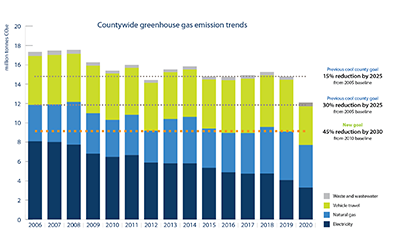Hennepin County’s Climate Action Plan
Our goal: net zero carbon emissions by 2050
 Globally, climate scientists agree that we need to substantially reduce emissions and make rapid and far reaching changes in all aspects of society to avoid the most severe impacts of climate change.
Globally, climate scientists agree that we need to substantially reduce emissions and make rapid and far reaching changes in all aspects of society to avoid the most severe impacts of climate change.
Hennepin County has adopted ambitious greenhouse gas emission reduction goals to reflect that need. These goals position Hennepin County as a leader on addressing climate change in the upper Midwest.
Net zero carbon emissions is achieved by “balancing” a limited amount of carbon released with offsets that remove carbon from the atmosphere. These emission reduction targets apply to both the geographic area of the county and county operations.
Climate Action Plan strategies
Hennepin County’s Climate Action Plan includes strategies to cut greenhouse gas emissions and adapt to the changing climate in ways that reduce vulnerabilities and ensure a more equitable and resilient Hennepin County.
View the Climate Action PlanPDF (91 pages - 8MB)
Download the Climate Action Plan

Explore the strategies
The path to achieving our greenhouse gas emission reduction goals
Achieving the county's ambitious greenhouse gas emission reduction goals will require big changes in the energy we use, how we get around, and the goods we buy. It also requires practices that remove carbon from the atmosphere and working in sync with our partners. These charts show the path forward to meeting the county’s goals.
Greenhouse gas emission sources
Hennepin County's greenhouse gas emissions inventory summarizes countywide emissions from the following sources. About 2/3 of emissions come from energy use, 1/3 from transportation, and a small fraction from waste.
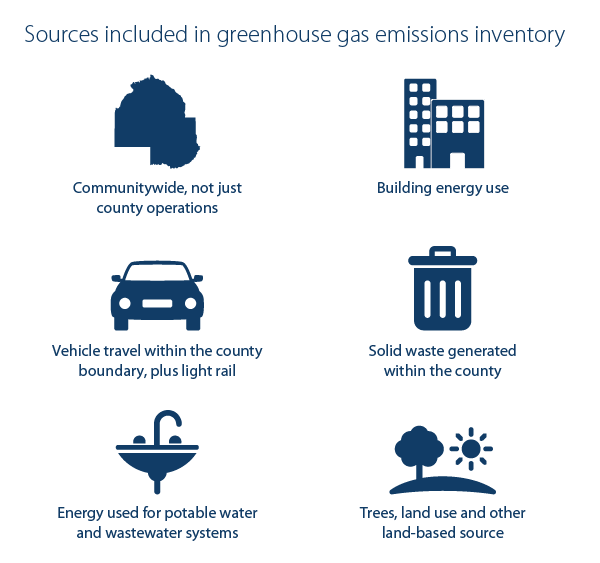
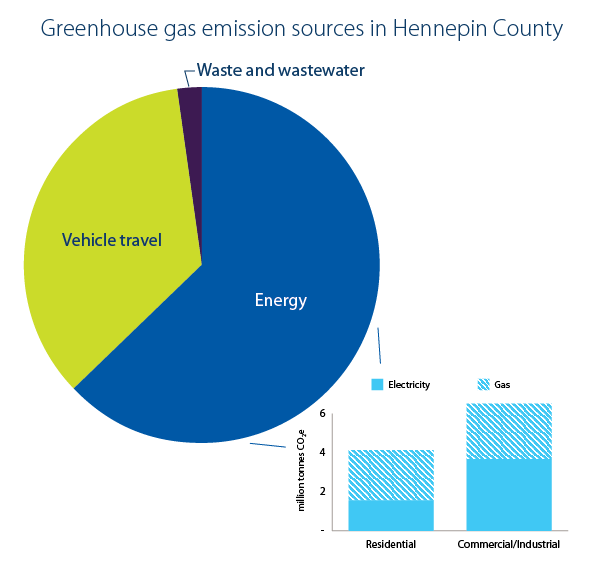
How we get to net zero greenhouse gas emissions by 2050
Starting after 2020, the solid line across the top of the chart is a forecast of business-as-usual based on anticipated population and job growth out to 2050. The dotted line trending down to 2050 shows how the county can meet its net zero greenhouse gas reduction goal. The stars at 2025 and 2030 show the emission reduction targets established by the county board.
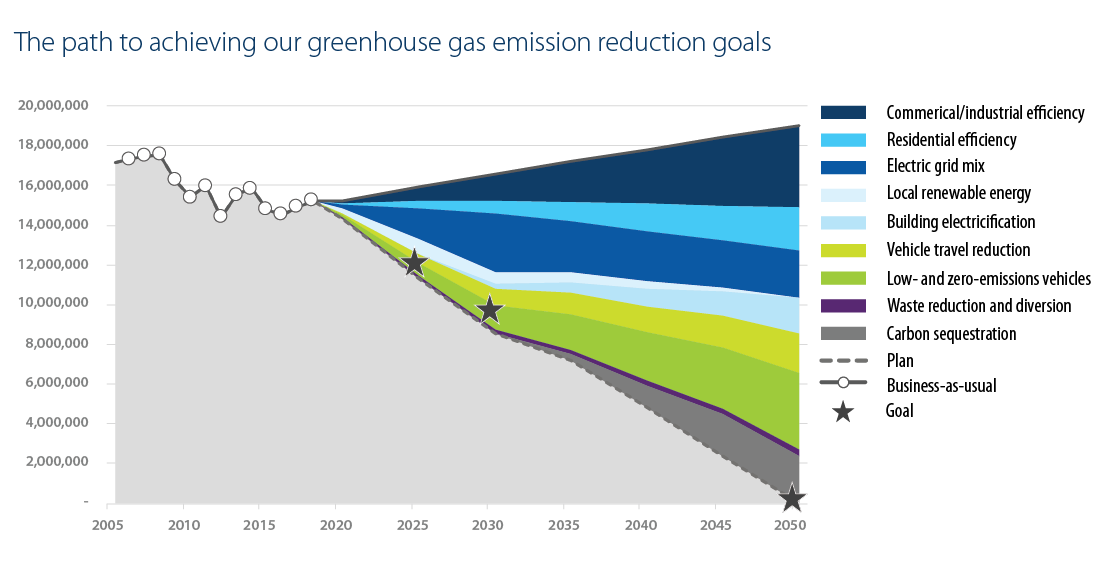
Emission reductions needed from energy use
On the energy side in blue, the county has a role to play in leading by example in achieving carbon-free electricity, making energy efficiency improvements, and electrifying buildings. The county will also support other local governments in adopting these efforts.
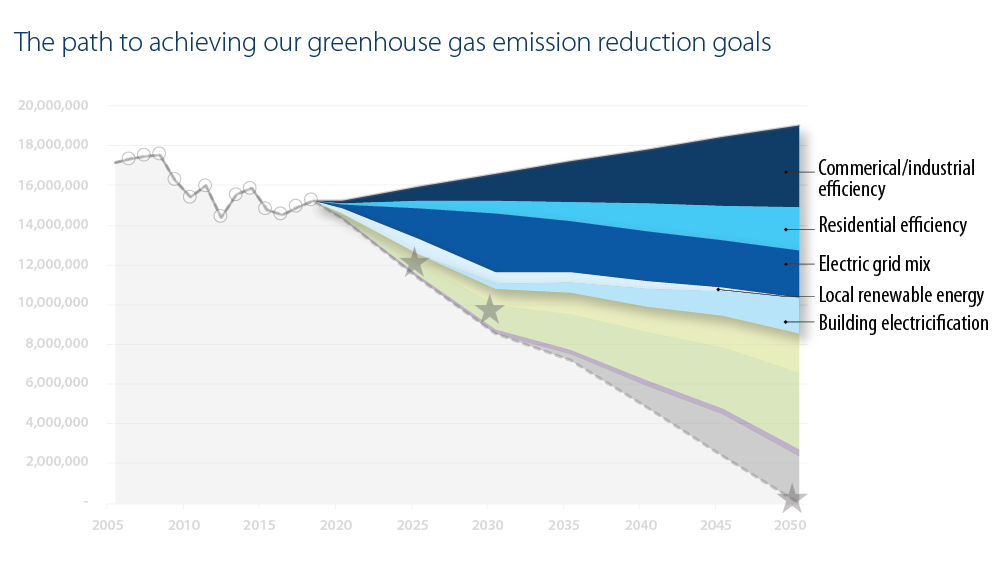
Emission reductions needed from transportation
For transportation in green, the county plays an important role in reducing vehicle-related emissions within the county’s transportation network and supporting transit and transit-oriented development.
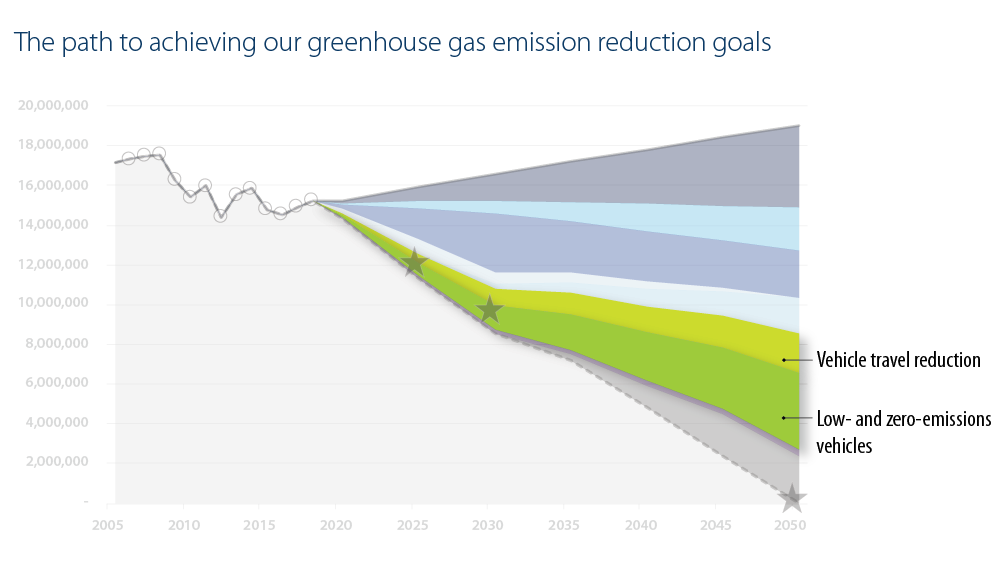
Emission reductions needed from waste
With waste and material use in purple, the county’s responsibility to manage a solid waste system provides numerous opportunities to advance waste reduction and recycling.
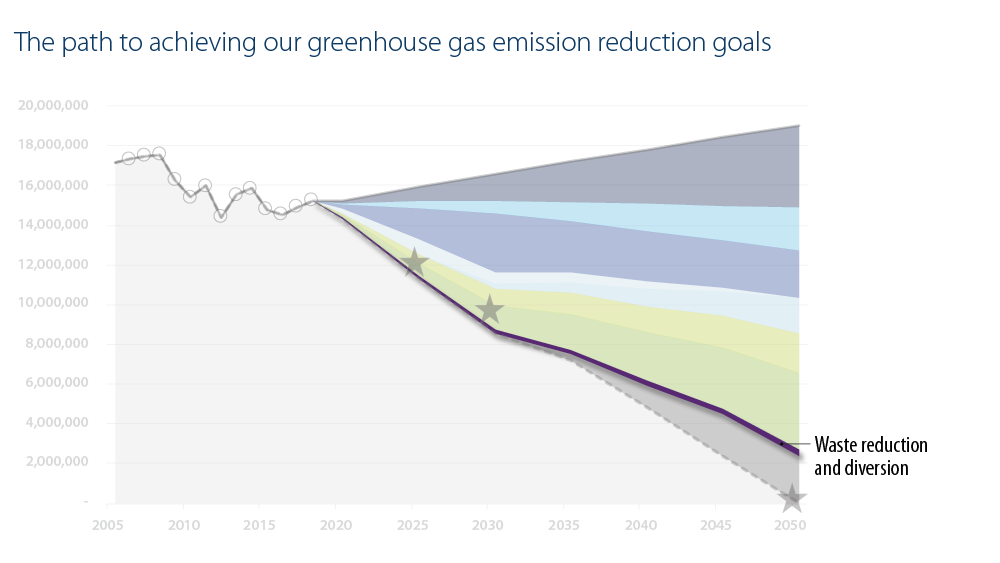
Emission reductions needed from carbon sequestration
With carbon sequestration in gray, the county’s natural resources and land management work offer opportunities to improve soil health, restore habitats, plant trees, and use compost and biochar in landscaping projects.
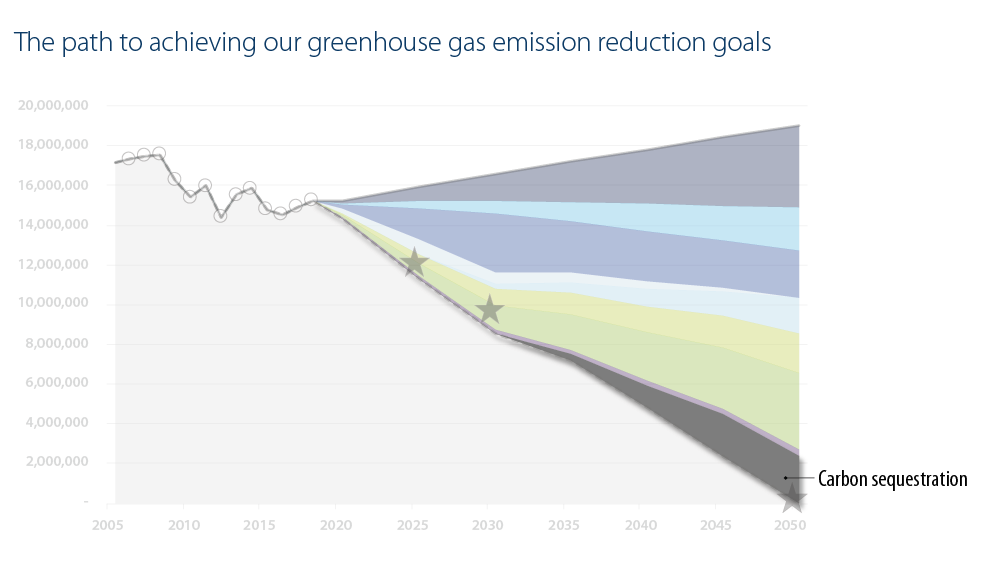
How the plan was developed
The development of the climate action plan included multiple phases:
- Phase 1: Research and assessment on climate change impacts and greenhouse gas emissions
- Phase 2: Develop goals and strategies
- Phase 3: Review, build support, and seek approval
- 2021 and beyond: Seek and facilitate partnerships to accomplish the work
Staff from every line of business in the county were engaged in work teams to develop goals and strategies. A disparities reduction lens was applied to each of the brainstormed strategies.
The county’s approach to engagement began with internal coordination and commitment. It then expanded to include public entity and community group partners, and then residents and businesses more broadly.
Supporting documents
Community engagement
- First phase of public engagement in fall 2020: Feedback sessions summary (PDF) and survey results (PDF)
- Second phase of public engagement in February and March 2021: Feedback summary (PDF) and verbatim comments (PDF)
- Final public comment period in April 2021: All comments (XLSX)
Key findings from the research and assessment phase
- Summary of key findings from the vulnerability assessment and greenhouse gas emission sources and trends in Hennepin County (PDF), presentation developed for county commissioners
- Hennepin County Climate Vulnerability Assessment (PDF 10MB)
- Hennepin County Climate Vulnerability Assessment executive summary (PDF)
 Climate change is likely to bring more abrupt and challenging situations, such as flash floods or severe weather, that worsen existing disparities. A climate hazard, such as water in the basement, could be an inconvenience for some, a manageable problem for others, or a catastrophic event for those without the means to respond. Building a more resilient community at both the individual and community level will help disrupt disparities and protect our society, economy, and public health.
Climate change is likely to bring more abrupt and challenging situations, such as flash floods or severe weather, that worsen existing disparities. A climate hazard, such as water in the basement, could be an inconvenience for some, a manageable problem for others, or a catastrophic event for those without the means to respond. Building a more resilient community at both the individual and community level will help disrupt disparities and protect our society, economy, and public health. The impacts of climate change will affect all residents, but the impacts will not be felt equally.
The impacts of climate change will affect all residents, but the impacts will not be felt equally.
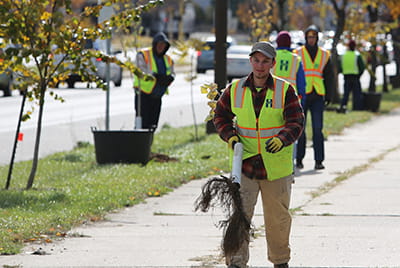 New green infrastructure on land and property that Hennepin County owns and manages will help respond to projected changes in precipitation. Installing, establishing, and maintaining this infrastructure creates an opportunity to train a new green workforce and define new contract standards.
New green infrastructure on land and property that Hennepin County owns and manages will help respond to projected changes in precipitation. Installing, establishing, and maintaining this infrastructure creates an opportunity to train a new green workforce and define new contract standards. The county’s emergency management work includes preparing for, mitigating against, responding to, and recovering from disasters to ensure public safety and health.
The county’s emergency management work includes preparing for, mitigating against, responding to, and recovering from disasters to ensure public safety and health. Being prepared for hazard events helps to minimize loss of life, personal injury, and damages to buildings and infrastructure, such as water supplies, sewers, and utility transmission lines, as well as natural, cultural, and historic resources.
Being prepared for hazard events helps to minimize loss of life, personal injury, and damages to buildings and infrastructure, such as water supplies, sewers, and utility transmission lines, as well as natural, cultural, and historic resources. Transportation infrastructure is currently designed to handle a broad range of impacts based on historic climate records and familiar seasonal variations. Preparing for climate change and extreme weather events using projections of increased precipitation and heavier rainfall events is critical to protecting the integrity of the transportation system and the sound investment of taxpayer dollars.
Transportation infrastructure is currently designed to handle a broad range of impacts based on historic climate records and familiar seasonal variations. Preparing for climate change and extreme weather events using projections of increased precipitation and heavier rainfall events is critical to protecting the integrity of the transportation system and the sound investment of taxpayer dollars. Surface water impacts are determined by how much and how quickly precipitation falls and by the ability of soils to infiltrate water or the capability of storm water conveyance systems to drain it away. Increased precipitation also increases groundwater recharge, which in many cases results in a rise in local water tables. This can create groundwater flooding, which is already occurring in several locations in Hennepin County.
Surface water impacts are determined by how much and how quickly precipitation falls and by the ability of soils to infiltrate water or the capability of storm water conveyance systems to drain it away. Increased precipitation also increases groundwater recharge, which in many cases results in a rise in local water tables. This can create groundwater flooding, which is already occurring in several locations in Hennepin County. Green Infrastructure refers to ecological systems, both natural and engineered, that act as living infrastructure. Examples include rain gardens, bio-swales, and green roofs. These systems restore some of the natural processes required to manage water and create healthier urban environments.
Green Infrastructure refers to ecological systems, both natural and engineered, that act as living infrastructure. Examples include rain gardens, bio-swales, and green roofs. These systems restore some of the natural processes required to manage water and create healthier urban environments. Hennepin County has an abundance of natural areas and diverse landscapes that provide critical habitat for wildlife, protect water quality, offer recreational opportunities, and serve as the foundation for the region’s environmental wellbeing, economic prosperity, and collective quality of life.
Hennepin County has an abundance of natural areas and diverse landscapes that provide critical habitat for wildlife, protect water quality, offer recreational opportunities, and serve as the foundation for the region’s environmental wellbeing, economic prosperity, and collective quality of life. As a large organization, a major consumer of energy, and an energy generator, Hennepin County can have a significant impact through efforts to reduce energy use and improve energy efficiency in buildings.
As a large organization, a major consumer of energy, and an energy generator, Hennepin County can have a significant impact through efforts to reduce energy use and improve energy efficiency in buildings. Hennepin County plans, funds, builds, and manages a transportation network of roadways, bikeways, and sidewalks. Long-term partnerships have produced an increasingly dense network of transit and transportation options that include light rail transit, bus rapid transit, commuter rail, bikeways, and pedestrian walkways.
Hennepin County plans, funds, builds, and manages a transportation network of roadways, bikeways, and sidewalks. Long-term partnerships have produced an increasingly dense network of transit and transportation options that include light rail transit, bus rapid transit, commuter rail, bikeways, and pedestrian walkways. Creating new products requires energy – to harvest raw material, process it, manufacture it, transport it, and sometimes, to use it. When looking at emissions to show how they are tied to the production of materials and goods, producing and transporting goods is associated with 45% of global emissions.
Creating new products requires energy – to harvest raw material, process it, manufacture it, transport it, and sometimes, to use it. When looking at emissions to show how they are tied to the production of materials and goods, producing and transporting goods is associated with 45% of global emissions. Carbon sequestration is the process of capturing and storing carbon dioxide from the atmosphere. This is a critical part of achieving net zero carbon emissions since it involves “balancing” a certain measured amount of carbon released with an amount of carbon offsets.
Carbon sequestration is the process of capturing and storing carbon dioxide from the atmosphere. This is a critical part of achieving net zero carbon emissions since it involves “balancing” a certain measured amount of carbon released with an amount of carbon offsets. Cities, watershed organizations, park districts, and other regional and state units of government have been engaged to share their priorities for climate work and opportunities for collaboration and to gather feedback on proposed strategies that will require external partnership and greater coordination to achieve.
Cities, watershed organizations, park districts, and other regional and state units of government have been engaged to share their priorities for climate work and opportunities for collaboration and to gather feedback on proposed strategies that will require external partnership and greater coordination to achieve. Feedback during the development of the plan was gathered from representatives from nonprofit, community-based organizations, high-school-aged youth involved in environmental and climate change groups, and the county’s Race Equity Advisory Council. Partners expressed strong interest in collaboration and commitment to working with us to ensure our plan is effective and impactful.
Feedback during the development of the plan was gathered from representatives from nonprofit, community-based organizations, high-school-aged youth involved in environmental and climate change groups, and the county’s Race Equity Advisory Council. Partners expressed strong interest in collaboration and commitment to working with us to ensure our plan is effective and impactful.